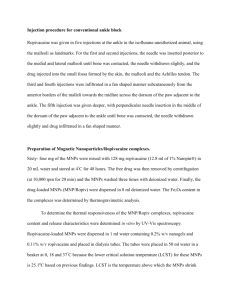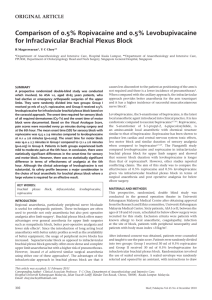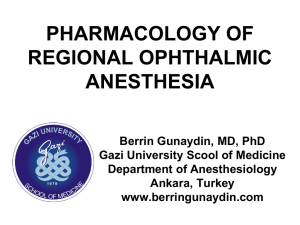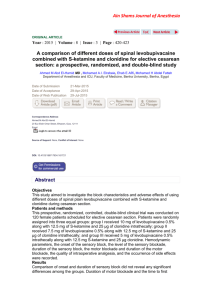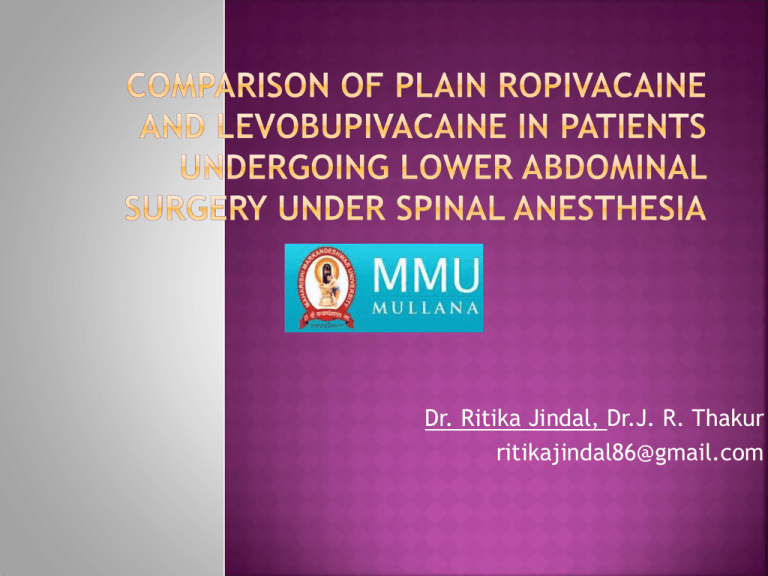
Dr. Ritika Jindal, Dr.J. R. Thakur
ritikajindal86@gmail.com
Spinal anesthesia is widely used, providing a fast onset and effective
sensory and motor blockade.
Bupivacaine a commonly used drug is available as a racemic mixture of
its enantiomers, dextrobupivacaine and levobupivacaine.
Ropivacaine and levobupivacaine have been introduced into clinical
practice because of their lower toxic effects for heart and central
nervous system.
The impetus for the development of these newer stereoselective,
single enantiomer amide local anaesthetic agents, ropivacaine and
levobupivacaine, came from reports of fatal cardiac toxicity in
pregnant women receiving epidural bupivacaine and etidocaine for
Caesarean section.
Ropivacaine is well tolerated after intrathecal use, and was found to
have a shorter duration of action than bupivacaine. Racemic bupivacaine
and levobupivacaine, its S enantiomer, appear to produce a very similar
pattern of the block.
To compare safety and efficacy of either plain ropivacaine 15
mg or plain levobupivacaine 15 mg in patients undergoing
lower abdominal surgery under spinal anesthesia.
A randomised double blind study was carried out in 30 ASA grade1 and 2
adult patients of both sexes between age 18-60 years of age under going
lower abdominal surgery of 1.5 to 2 hours duration under spinal
anaesthesia at MMU, Mullana. Ambala after obtaining an informed
written consent from every patient.
INCLUSION CRITERIA
.
Either sex
ASA grade I and II
Age group 18- 60 years
THE FOLLOWING PATIENTS WERE EXCLUDED FROM THE
STUDY:
1. Any contradiction for spinal anaesthesia
Bleeding disorder or an anticoagulant therapy
Local sepsis around spine.
Patient with increased intracranial tension
Spinal deformity
Psychiatric illness/uncooperative patients
Neurological deficits, history of epilepsy.
2 .Patient refusal
3. Patient not able to understand pain assessment test.
4. Patient with history of drug allergy.
5 . Patient with cardiovascular disease or mental retardation
Patients thus selected are divided into 2 groups of 15 each.
Pre-operative evaluation
Thorough pre-operative checkup with detailed history and physical
examination was done day before surgery. All patients were thoroughly
investigated as per the requirement of the surgery apart from routine
investigations .
Special investigation were done as per need.
A written informed consent was taken.
Spinal block procedure and Visual analogue scale score for pain
assessment was explained to the patient.
All patients were kept fasting over night.
Tab Ranitidine(150mg) and Tab Alprax(0.25mg) was given to all the
patients in night and repeatedly in early morning on day before surgery
ALLOCATION OF GROUPS
Using a sealed envelope technique, patients were randomly allocated
to two groups :
GROUPI - 15 PATIENTS- LAEVOBUPIVACAINE(0.5%)3ml
GROUPII- 15 PATIENTS-ROPIVACAINE(0.75%)3ml.
Total drug volume injected: 3ml
All 3-ml solutions were prepared in an adjacent room by a supervisor
not involved in the subsequent evaluation of the study-patient.
ANAESTHETIC TECHNIQUE
After taking the patient in operation theatre a multipara vital monitors
was attached and preoperative pulse rate, blood pressure and oxygen
saturation recorded and treated as baseline.
Anaesthesia trolley, anaesthesia circuit and all the resuscitation
equipments and drugs were kept ready.
A suitable wide bore i.v line was taken with 18g intracath. Preloading
was done with ringer lactate 15 ml/kg body weight 20 minutes before
surgery.
Spinal anaesthesia was given in lateral position under all aseptic
precautions at L 3-4 intervertebral space. After confirming the free
flow of CSF the patients was administered levobupivacaine (0.5%) in
group I and ropivacaine (0.5%) in group II . The total volume injected
was 3 ml. Then patient was reverted in supine position immediately.
Following observations were made:
Time to onset of motor block (Bromage 3)
Duration of motor block
Onset of sensory block
Duration of sensory block
Peak sensory levels achieved
Time taken to reach peak sensory level
Time taken for two segment regression
All the patients will be given maintenance fluids. Blood loss will be
replaced if excessive.
INTRAOPERATIVE MONITORING
The following vitals were recorded
Blood pressure
Pulse rate
Oxygen saturation
Respiratory rate.
Heart rate and arterial pressure were recorded before intrathecal
injection, 5 minutes after the intrathecal drug administration, and
thereafter every 10 minutes till the end of the operation and one
hour after the end of the operation, at the ward.
Any hypotension (mean arterial pressure lower than 60 mmHg) or
bradycardia (heart rate< 50/min) incidents were treated with
mephenteramine 5 mg or atropine 0.5 mg increments.
A decrease in SpO2 to < 93% was defined as hypoxia and treatedwith
supplemental oxygen via a Venturi - mask 40%at 10 l/min.
SENSORY BLOCKADE:
• The level of sensory block was evaluated by loss of pinprick
sensation.
• S1, L3, T12, T10, T8, T6 or higher (T4) dermatomes were
checked bilaterally .
• C5-6 was used as baseline point for normal sensation.
•Sensory onset was taken as loss of pin prick sensations with 23
gauge needle at T10 level and the time was noted down.
• The test was performed every 5 minutes till loss of
discrimination to pinprick for the first 60 minutes and then
every 10 minutes until its full recovery.
•The duration of sensory blockade was defined as the interval
from intrathecal administration to the point of complete
resolution of the sensory block.
• Two segment regression of the block, peak sensory levels
achieved and time taken to reach peak sensory level were also
noted .
MOTOR BLOCKADE:
Motor onset after the intrathecal administration was taken as achievement
of bromage score 1 and was considered full after score reached grade 3.
The duration of motor blockade was defined as the interval from
intrathecal administration to the point in which the Bromage score was back
to zero.
Time taken to achieve both the grades was noted down with maximum
Bromage grade and duration of motor blockade was also noted down.
BROMAGE SCORE
Grade 0: no motor blockade
Grade 1: unable to raise extended leg
Grade 2: unable to flex knee.
Grade 3: unable to flex ankle.
POST OPERATIVE MONIOTORING: After the surgery is over sensory levels
were again noted for regression of the block and vitals recorded.
ANALGESIA: The degree of analgesia was determined by visual analogue score. It
is a 10 cm scale with a mark from 0-10 with 1 cm apart. The mark 0 denotes no pain
and the mark 10 denotes worst pain. The patient will be asked to mark a point on the
scale which corresponds with the intensity of pain he/she feels.
0
1
2
3
4
5
6
7
8
9
10
NO
EXCRUCIATING
PAIN
PAIN
• - No Pain
• 1-2 – Mild pain
• 2-4- Moderate pain
• 5-7 – Severe pain
• 8-10 – Worst pain
RESCUE ANALGESIA:
When VAS will be ≥ 4 inj. Diclofenac Sodium 1.5mg/kg(max 75mg) was given
intramuscularly as rescue analgesia. Inj. Diclofenac Sodium was repeated
intramuscularly if the patient complained of pain(VAS=4) in next 24 hours. The total
no. of doses of rescue analgesic required in 24 hr. will be compared in both the
groups.
The occurrence of adverse events, including bradycardia, hypotension, decrease
in oxygen saturation SpO2 < 93%, tremor, as well as nausea and vomiting were also
recorded.
Total patients - 30(15 patients in each group).
Demographic features of both the groups were comparable.
The characteristics of the three groups were comparable in terms of age,
height, weight, gender, body mass index (BMI), and ASA physical status.
Time of surgery was comparable also
CHARACTERSTICS OF SENSORY BLOCK ON INTRATHECAL
ADMINSTRATION OF 15 MG OF LEVOBUPIVACAINE AND 15 MG
OF ROPIVACAINE
PARAMETER
LEVOBUPIVACAINE ROPIVACAINE
ONSET (MIN.)
12.1
14.4
PEAK SENSORY LEVEL
T6-T8
T6-T8
TIME TO REACH PEAK
SENSORY LEVEL
12.3
13.2
DURATION OF SENSORY
BLOCK(MINS)
257.4
224.2
TIME TO 2-SEGMENT
REGRESSION ( T8-T10)
66.8
62
PARAMETER
LEVOBUPIVACAINE
ROPIVACAINE
ONSET (MIN.)
12
12.5
DURATION (MIN.)
313.2
274
This study shows that the intrathecal administration of either 15
mg ropivacaine or 15 mg levobupivacaine was well tolerated and an
adequate block for lower abdominal surgery was achieved in all
patient in each group.
There was only a slight reduction in mean arterial blood pressures
after the spinal injection in both groups. None of the groups
required the use of mephenteramine for hypotension.
Levobupivacaine has a faster onset and longer duration of sensory
block than ropivacaine.
Peak sensory level achieved by both is same (T6-T8).
Time to achieve peak sensory level was longer in ropivacaine.
Time for two segment regression was longer in levobupivacaine
Levobupivacaine has a faster onset and longer duration of motor
block than ropivacaine.
No adverse events like nausea, vomiting, tremor, and decrease in
oxygen saturation SpO2 < 93% were noted.
Intrathecal
ropivacaine may prove useful
when surgical anesthesia of a similar quality
but of a shorter duration than
levobupivacaine is required in patients with
cardiovascular instability in whom
bupivacaine is undesirable.
1.
2.
3.
Albright GA. Cardiac arrest following
regional anaesthesia with etidocaine or
bupivacaine. Anesthesiology 1979;51:2857.CrossRefMedlineWeb of Scienc.
Markham A., Faulds D., Ropivacaine. A
review of its pharmacology and
therapeutic use in regional
anaesthesia,DRUGS 1996; 52 (3): 429-49.
Burke D, Kennedy S, Bannister J. Spinal
anesthesia with 0.5% S(-)-bupivacaine for
elective lower limb surgery. Reg Anesth
Pain Med 1999; 24:519–23
4. Foster R. H., Markham A., Levobupivacaine : a
review of its pharmacology and use as a local
anaesthetic, DRUGS 2000;59 (3): 551-79.
5. Glaser C, Marhofer P, Zimpfer G, et al.
Levobupivacaine versus racemic bupivacaine for
spinal anesthesia. Anesth Analg 2002; 94:194–8.
6. Alley EA, Kopacz DJ, McDonald SB, Liu
SS.Hyperbaric spinal levobupivacaine: a comparison
to racemic bupivacaine in volunteers.Anesth Analg
2002; 94: 188–93.
7. Whiteside JB, Burke D, Wildsmith JAW. Comparison
of ropivacaine 0.5% (in glucose 5%) withbupivacaine
0.5% (in glucose 8%)for spinal anaesthesia for
elective surgery. Br J Anaesth 2003; 90:304–8.
8.
8.Milligan K. R., Recent advances in local
anaesthetics for spinal anaesthesia, EUR. J.
ANAESTHESIOL. 2004; 21: 837-847.
9. Capelleri G, Aldegheri G, Danelli G, et al. Spinal
anesthesia with hyperbaric levobupivacaine and
ropivacaine for outpatient arthroscopy: a
prospective, randomized, double-blind study.
AnesthAnalg 2005; 101: 77–82
10. Fettes PDW, Hocking G, Peterson MK, Luck JF,
Wildsmith JAW.Comparison of plain and hyperbaric
solutions of ropivacaine for spinal anaesthesia. Br J
Anaesth 2005; 94: 107–11
THANK YOU



